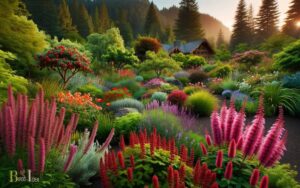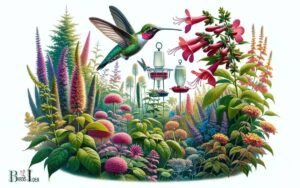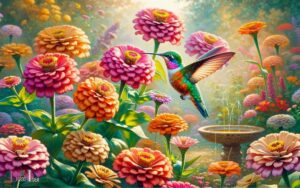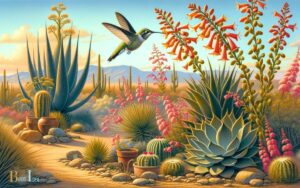Does Confederate Jasmine Attract Hummingbirds? Yes!
Yes, Confederate jasmine (Trachelospermum jasminoides), also known as star jasmine, can attract hummingbirds.
The vine’s fragrant, white flowers provide a source of nectar that hummingbirds find appealing.
Confederate jasmine is a popular evergreen vine known for its star-shaped, fragrant white flowers that typically bloom in the spring and summer.
While it is not as well-known for attracting hummingbirds as some other plants, its nectar-rich blossoms can indeed attract these tiny birds.
Hummingbirds are drawn to a variety of flower types, primarily those that are brightly colored and have a tubular shape, which are indicative of nectar.
Although Confederate jasmine’s flowers are not tubular, they still produce nectar and can attract hummingbirds, especially when other preferred food sources are scarce.
By incorporating Confederate jasmine into your garden, you can enjoy the dual benefits of its sweet scent and the chance to observe visiting hummingbirds.
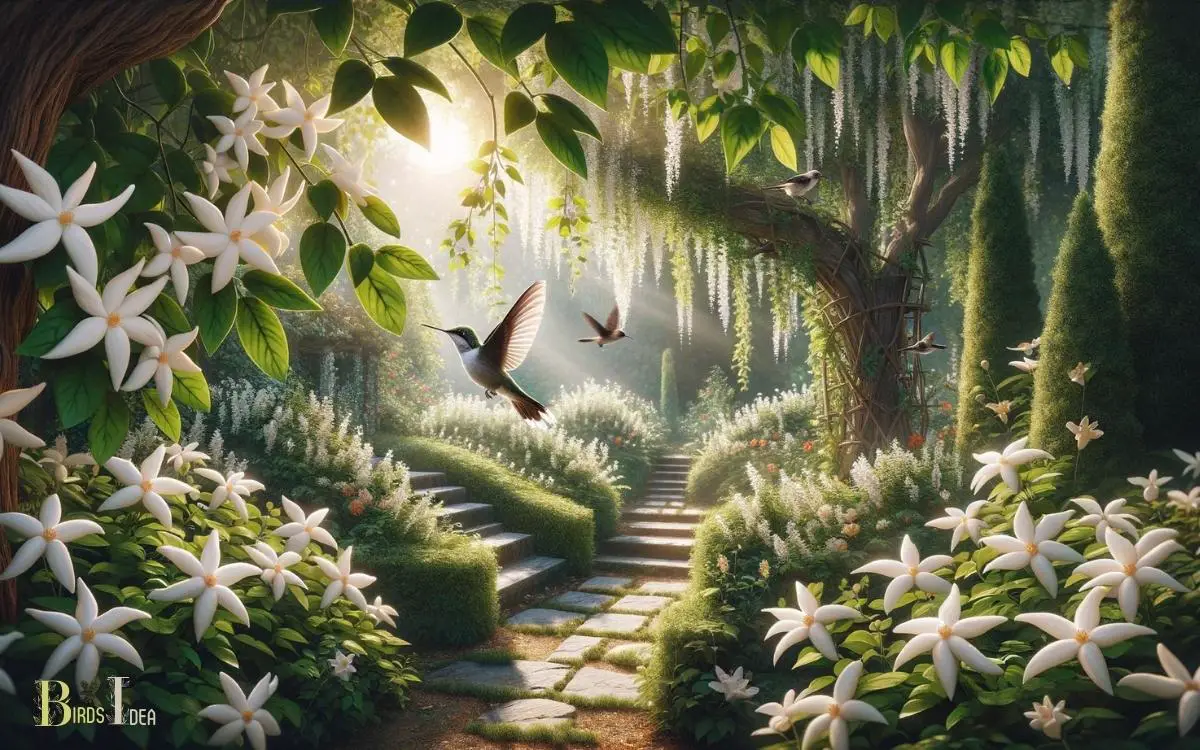
Key Takeaway
Comparative Analysis: Confederate Jasmine vs. Hummingbird Preferences
| Feature | Confederate Jasmine | Hummingbird Preferences |
|---|---|---|
| Flower Color | White | Reds and Oranges |
| Nectar Production | Moderate | High |
| Scent | Fragrant | Not a key factor |
| Bloom Shape | Tubular | Long and Tubular |
| Attractiveness to Birds | Moderate | High for preferred traits |
The Characteristics of Confederate Jasmine
It is known for its fragrant white flowers and vigorous climbing habit, making Confederate jasmine a popular choice for gardeners seeking a versatile and visually appealing plant.
This evergreen vine, also known as Trachelospermum jasminoides, is native to East Asia and belongs to the Apocynaceae family.
Confederate jasmine is prized for its ability to cover fences, walls, and trellises with lush green foliage and sweet-scented blooms.
Its glossy, leathery leaves provide year-round interest, and the plant is relatively low-maintenance once established.
It thrives in full sun to partial shade and well-drained soil, making it adaptable to various growing conditions.
Additionally, Confederate jasmine is often used as ground cover or as a fragrant addition to outdoor spaces, attracting pollinators like bees and butterflies.
The Behavior of Hummingbirds
The fragrant white flowers and sweet scent of Confederate jasmine make it an attractive option for attracting hummingbirds to the garden.
Hummingbirds are known for their unique behaviors, such as hovering mid-air and their ability to fly backwards.
These agile birds have a high metabolism and need to feed frequently, making nectar-rich flowers like Confederate jasmine a great food source.
They are also highly territorial and will defend a prime feeding spot, often engaging in aerial battles with other hummingbirds.
Their long bills and specialized tongues allow them to extract nectar from tubular flowers like those of the Confederate jasmine.
Additionally, hummingbirds are known for their remarkable memory and will revisit reliable food sources, making your garden a regular stop for these fascinating creatures if you plant Confederate jasmine.
Understanding Hummingbird Attraction
When it comes to understanding hummingbird attraction, it’s important to consider the types of flowers that entice them with nectar-rich blooms.
Brightly colored flowers also play a significant role in catching the attention of these tiny birds.
Additionally, carefully placing vines in the garden can create an inviting environment for hummingbirds to visit.
Nectar-Rich Flowers Entice
How do nectar-rich flowers entice hummingbirds? Hummingbirds are attracted to nectar-rich flowers due to the high energy content of the nectar they produce.
The high sugar concentration in the nectar serves as a valuable fuel source for the energetic hummingbirds.
Additionally, the bright and vivid colors of nectar-rich flowers serve as visual cues for hummingbirds, attracting them to these blooms.
The shape of the flowers also plays a role, as certain nectar-rich flowers are specifically adapted to fit the long, slender bills of hummingbirds, making it easier for them to access the nectar.
By understanding the factors that entice hummingbirds to nectar-rich flowers, individuals can strategically plant these flowers in their gardens to attract and support these delightful birds.
Brightly Colored Blooms Attract
Many brightly colored blooms attract hummingbirds due to their vibrant hues and high nectar content, making them a desirable food source for these energetic birds.
The following factors contribute to the attraction of brightly colored blooms for hummingbirds:
- Color Perception: Hummingbirds are drawn to bright, vivid colors such as red, orange, and pink, as these hues are easily visible to them from a distance.
- Nectar Production: Blooms with brightly colored petals often produce high amounts of nectar, providing the essential energy source for hummingbirds.
- Long Blooming Periods: Many brightly colored blooms have a long flowering season, ensuring a consistent food source for hummingbirds throughout the year.
- Shape and Structure: The shape and structure of brightly colored blooms, such as tubular or trumpet-shaped flowers, are perfectly suited for the unique feeding mechanisms of hummingbirds.
Consider Vine Placement Carefully
In the context of understanding hummingbird attraction, it is essential to carefully consider the placement of vines in the garden. Vines can provide shelter, nesting spots, and food sources for hummingbirds.
When choosing vine placement, it’s important to ensure that the vines are in close proximity to other hummingbird-attracting plants and feeders.
Vines that are positioned near nectar-producing flowers or feeders can create a natural feeding and resting area for hummingbirds.
Additionally, vines placed near trees or shrubs can offer safe perches and protection from predators.
The height and structure of the vines should also be considered, as hummingbirds prefer to feed at eye level.
By strategically placing vines in the garden, it is possible to create an inviting environment for hummingbirds to visit and thrive.
Understanding the factors that influence bird attraction can further enhance the garden’s appeal to hummingbirds.
Factors That Influence Bird Attraction
Factors such as flower color, nectar availability, and plant height influence bird attraction to Confederate Jasmine.
- Flower Color: Birds are attracted to bright and vivid flower colors, particularly shades of red, orange, and pink. These colors stand out in the landscape and are easily visible to birds from a distance.
- Nectar Availability: Birds are drawn to plants that offer a good supply of nectar. Confederate Jasmine produces abundant nectar, making it an attractive source of food for hummingbirds and other nectar-feeding birds.
- Plant Height: The height of the plant can affect its visibility to birds. Taller plants, such as those that have climbed up a trellis or fence, can be more easily spotted by birds flying overhead.
- Scent: Some birds are attracted to the scent of flowers. Confederate Jasmine emits a sweet fragrance, which can also contribute to its appeal to birds.
Confederate Jasmine and Hummingbird Interaction
Confederate jasmine, known for its fragrant blooms, is a popular choice for attracting hummingbirds to gardens.
The trumpet-shaped flowers of the jasmine plant provide a nectar source that can be particularly appealing to hummingbirds.
Understanding the interaction between Confederate jasmine and hummingbirds can offer insights into creating a hospitable environment for these vibrant avian visitors.
Jasmine for Hummingbirds
Most gardeners wonder whether jasmine attracts hummingbirds, and the answer is a resounding yes.
Hummingbirds are attracted to the fragrant blossoms of jasmine, making it a delightful addition to any garden wishing to attract these charming birds.
Here are four reasons why jasmine is an excellent choice for hummingbirds:
- Nectar Production: Jasmine flowers produce ample nectar, providing a valuable food source for hummingbirds.
- Long Bloom Period: Jasmine plants often have a long blooming period, offering a consistent nectar source for hummingbirds throughout the season.
- Fragrance Attraction: The sweet fragrance of jasmine flowers acts as a natural lure for hummingbirds, drawing them in for nectar.
- Shelter and Nesting Sites: Jasmine’s dense foliage provides shelter and potential nesting sites for hummingbirds, making it even more appealing to these tiny birds.
Attracting Hummingbirds With Jasmine
Attracting hummingbirds with Confederate Jasmine involves creating an environment that provides ample nectar, shelter, and nesting sites for these charming birds.
Confederate Jasmine, with its fragrant white flowers, can attract hummingbirds due to the abundant nectar it offers.
Below is a table outlining the key elements for attracting hummingbirds with Confederate Jasmine:
| Key Elements | Description |
|---|---|
| Ample Nectar | Provide abundant nectar-rich Confederate Jasmine flowers. |
| Shelter | Offer nearby shelter for hummingbirds to rest and perch. |
| Nesting Sites | Create suitable locations for hummingbird nests. |
| Proper Maintenance | Regularly care for plants, ensuring health and vitality. |
| Diverse Plantings | Include a variety of blooming plants to attract diversity. |
By incorporating these elements into a garden, one can create an inviting space for hummingbirds. These elements encourage hummingbirds to visit, feed, and potentially nest in the area.
Tips for Creating a Hummingbird-Friendly Garden
When creating a hummingbird-friendly garden, it’s important to include a variety of nectar-producing flowers and strategically place feeders to provide ample food sources for these delightful birds.
To attract hummingbirds, consider the following tips:
- Plant a diverse range of flowers that bloom at different times throughout the year to ensure a constant nectar supply.
- Choose tubular-shaped flowers such as salvia, bee balm, and trumpet vine, as they are well-suited for hummingbird beaks.
- Incorporate native plants into the garden, as they are well-adapted to the local environment and can provide a familiar food source for hummingbirds.
- Position feeders in shaded areas to prevent the nectar from spoiling too quickly and ensure they are easily accessible for regular cleaning and refilling.
Other Plants That Attract Hummingbirds
Incorporating a diverse selection of nectar-producing flowers and strategically placing feeders are essential for attracting hummingbirds to the garden.
Aside from Confederate Jasmine, there are several other plants that can attract these delightful birds.
- Salvia, also known as sage, is a popular choice due to its tubular flowers that are rich in nectar.
- Bee balm, with its vibrant and showy blooms, is another favorite among hummingbirds.
- Trumpet vine, with its trumpet-shaped flowers, and cardinal flower, known for its bright red blooms, are also highly attractive to hummingbirds.
- Additionally, incorporating native wildflowers such as columbine, penstemon, and lupine can further entice these tiny avian visitors.
By planting a variety of these nectar-rich flowers, gardeners can create an inviting environment that will undoubtedly attract hummingbirds to their outdoor space.
Conclusion
Confederate jasmine is like a magnet for hummingbirds! With its sweet fragrance and abundant nectar, it’s hard for these tiny birds to resist.
By adding this beautiful vine to your garden, you’ll be sure to attract a flurry of hummingbird activity.
So, don’t wait any longer – plant some Confederate jasmine and get ready to be amazed by the hummingbird show in your backyard!

